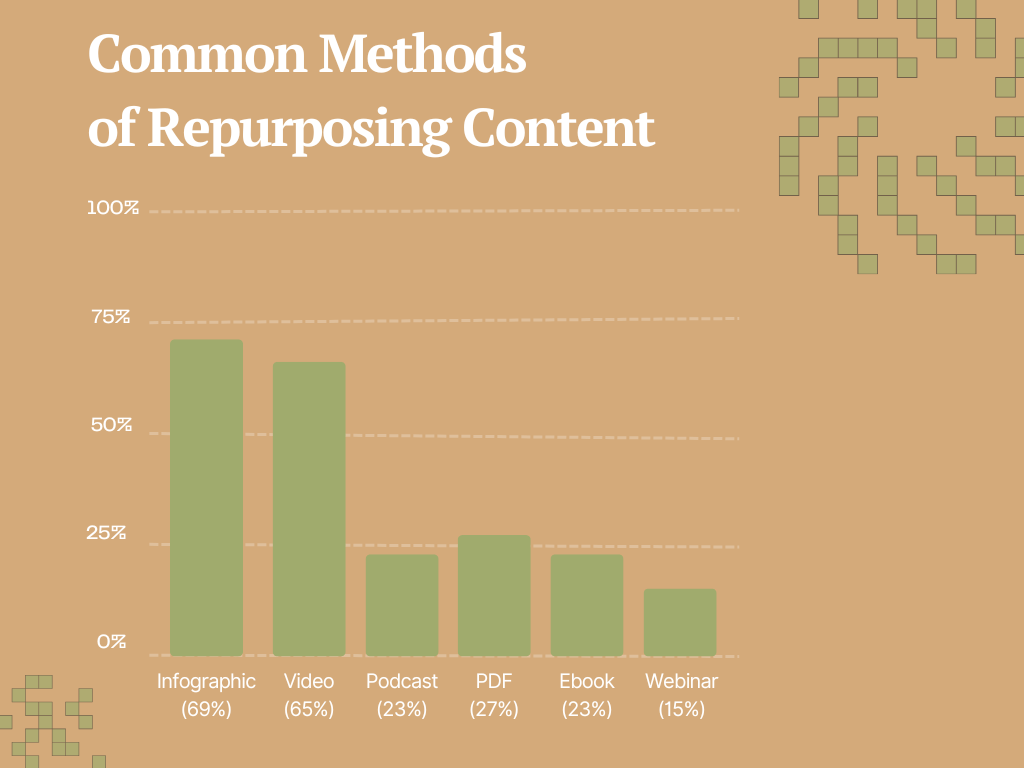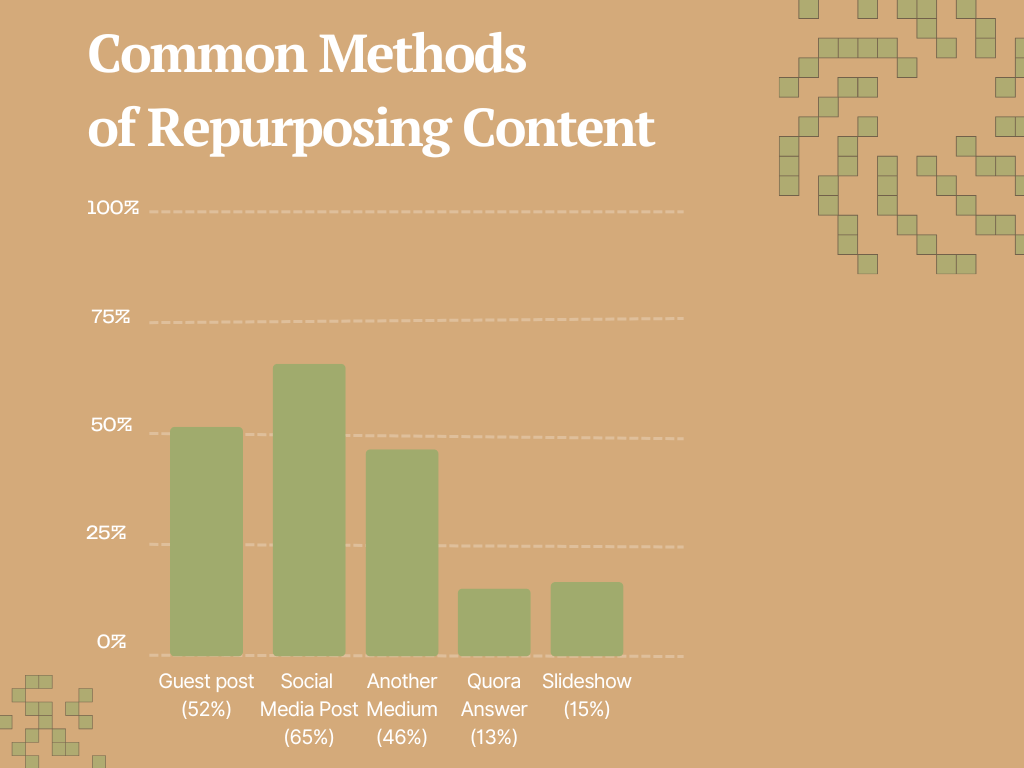Work Smarter, Not Harder: The Small Business Guide to Content Repurposing
As a content creator for a small business, you know how hard it is to keep putting out fresh content. Much of your valuable time may go toward researching and writing blog posts to help increase trust and authority. But the moment you complete one piece of content, it’s already time to start working on the next piece. How do you find the time for your other marketing activities?
Repurposing content is a great way for small business owners to save time and build on the success of their best-performing content. Recycling your content for different platforms allows you to reach a wider audience and increase your visibility.
In this post, we’ll cover the best practices for repurposing your content:
3 Different ways to produce new content
Practical, time-saving ways to leverage your most successful content by turning one piece into many
How repurposing content can help your SEO rankings
4 Effective ways to repurpose content if you’re brand new to repurposing
“46% of marketers surveyed said that repurposing content brought in the best results (leads, conversions, and so on).”
3 different ways to produce new content
When it comes to marketing content creation, you have some options. You can dig deep into a topic, research for supporting quotes and visuals, and create a new piece of content. This is an effective but time-consuming strategy with 33% of marketers stating that new content generates the best results (engagement, leads, and conversions). But, for established small business owners who already have a lot of content and are looking for ways to save time and money, this may not be the best option for you.
Another way to create new content is to refresh old content. 46% of marketers agreed that updating content was the most effective way to produce content while saving a lot of time. If you sort through your old posts, you will likely find old posts that are now dated. These posts are easy to update, and search engines are generally fond of up-to-date content.
Finally, you could repurpose some of your better-performing content. Repurposing your content was ranked highest for cost-effectiveness (65%). In addition, 46% of marketers stated that repurposing provides the best results (46%) for them. Repurposing content takes one piece of content and generates numerous others in different formats.
For example, you can use Canva to design posts for social media that highlight quotes from your blog post. You can create a short video summarizing your blog post and put that on your website or social media (or both). You can see from these examples how you will reach different audiences based on the format of the content.
The benefits of repurposing content
Leverage your content
Most small business owners put a lot of time and effort into content creation. By repurposing content, you can extend the lifecycle of your content and build on its original success. By using your original content as the basis for multiple pieces of content, you get maximal value out of your original work.
Reach a wider audience
Some people prefer to read a blog post, while others may prefer a video on YouTube or a podcast on their ride home from work. Everyone is different. By producing content in various formats, you will reach a much wider audience.
Save time
Does it feel like whenever you finish one blog post, the next one is due? Rather than starting another post from scratch, repurpose one of your previous posts (as long as it’s still relevant). You’ve already done the research, organizing, and writing for your original piece. It won’t take nearly as long to create new content based on your original post.
Improve your SEO results
When you repurpose content and post it across various platforms, your SEO results improve. People no longer rely solely on Google for searches anymore. They’re using AI, watching videos on YouTube, and checking out Instagram Reels. Your potential clients will have more ways to find you.
By now, I hope you see the value of repurposing content. Let’s explore how to get started.
Graph based on survey results from Referral Rock (https://referralrock.com/blog/content-repurposing-tips-from-experts/)
How to repurpose your marketing content
1 - Start with content that performed well
If you’re not sure which posts were your best performers, it’s time to take a look. Under the settings for your website host, look for your site analytics (or use an application like Google Analytics or Google Search Console) to see which posts ranked highest in visibility and engagement. Alternatively, you can look at the rankings of your landing pages. These are the pages that are drawing traffic to your website.
After you’ve selected a few possible candidates to repurpose, you can narrow your list down with two more qualifications. First, check to make sure the content is evergreen (still relevant today). The idea behind repurposing is to provide your audience with information that they are still interested in. Second, select content that has depth. Content that you created with research, visuals, and quotes provides plenty of information to draw from.
2. Find the most appropriate channel for your repurposed content
You shouldn’t try to recycle content for every channel. Some channels will prove significantly more effective for you than others. Focus on channels where you are either already performing well, or you’d like to grow your presence there. For example, if you are looking to grow your presence on Instagram, you may consider creating short videos for reels since Instagram is a highly visual medium. Or you could overlay quotes from your blog over a visual created on Canva or Vennage.
3. Alter your content to fit the channel
When you repurpose your content, try to think about what works best on different media. For example, a text-heavy blog could be repurposed by adding visuals and short highlights for social media. If you used a lot of statistics or graphs, consider creating infographics to highlight the important figures at a glance. Repurpose a webinar for a YouTube video where you can add captions and transitions.
The key to a successful repurpose is to change the content in some way. For example, if your blog post was titled: The 7 Essential Marketing Strategies for Small Business Owners in 2025. You could change it to: Game-Changing Marketing Strategies to Boost Profits in 2025 and tweak the wording and format so that the new version of your content is appropriate for the channel you’ve selected.
“Even your most dedicated followers will only consume a fraction of the content you create. Repurposing it into several different forms gives people multiple opportunities to engage with your brand. ”
Your quickstart guide for repurposing content
Following are methods many other businesses have successfully used to repurpose content. They’re not complicated and don’t require much technical expertise to prepare.
Creating social media posts
From your in-depth content, highlight several key takeaways and turn them into short social media posts. For example, you could use Canva to create an eye-catching background for each takeaway or quote. For each tip you share from your in-depth content, you should be able to generate several posts for LinkedIn or Instagram.
Transform your content into an email newsletter
Email marketing remains one of the most effective and cost-efficient methods for B2B and B2C businesses to reach their target audiences. If you have an email list, you can turn your content into an email newsletter by summarizing the main points of a blog post and incorporating some personal insight. At the end of the piece, add a call to action (for example, a button with a link to the original content) so readers know what to do next.
Create a video or reel from your content
When I attended a marketing conference in the fall of 2024, the message emphasized to all of us was to double down on creating videos. You can create a script based on the original content and add some insights and visuals to make it more engaging. It can be posted to YouTube and embedded on your website or shared on social media.
If you’re dreading the thought of doing videos (let’s face it, not all of us love being in front of a camera), start small. Create a 30-60-second summary of the content and post it at the end of the original content. That same short video can be posted on social media along with the link to the original content. Bonus points if you can add captions to the video since some people view them with the sound off.
Create a downloadable resource
We all love free resources that make our lives easier. By offering a checklist, PDF guide, or infographic, you are building trust with potential clients. Small business owners can offer a downloadable PDF as gated content that will help grow their email list. The downloadable content can be drawn from various sources, including blog posts, articles, and white papers. The key is to create something that your audience values.
Adapt posts for other platforms
Your blog posts can be altered to be shared through other channels, such as LinkedIn articles, Medium, or Quora. This allows you to reach new audiences with minimal effort. In addition, you could refresh and reshare an old blog post and add some new thoughts or ideas. Social media posts that performed well can serve as the basis for short-form blogs.
Graph based on survey results from Referral Rock (https://referralrock.com/blog/content-repurposing-tips-from-experts/)
How to make repurposing easy
One of the best ways to organize and simplify your repurposing projects is to plan ahead. Whenever you create a new piece of content, create an outline and break it down into its components (credit to the free Hubspot Academy course, Content Marketing Lesson: Extending the Value of Your Content Through Repurposing, for this tip). If you’re including quotes, list them in one section, definitions in a separate section, and a 5-step how-to guide in another section. When it’s time to repurpose your content, you can return to your outline where you can easily pull information from it.
As you can see from this post, repurposing content is easy to do. You will get more value from each piece of content you produce, expand your reach, save time, and continue to grow your brand presence. If you’ve never repurposed your content, I’d suggest selecting one method from the list above and giving it a shot. Let me know how it goes.



